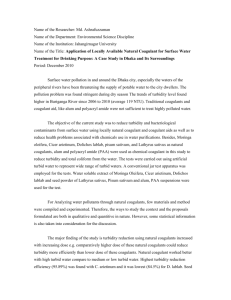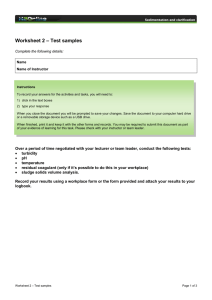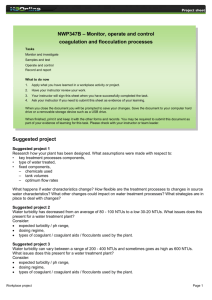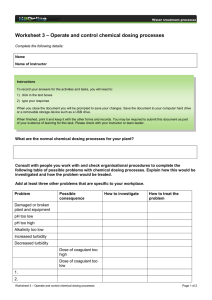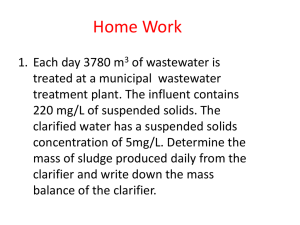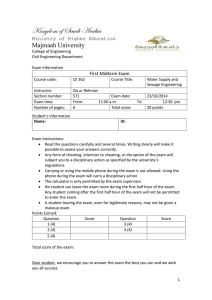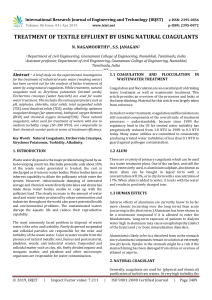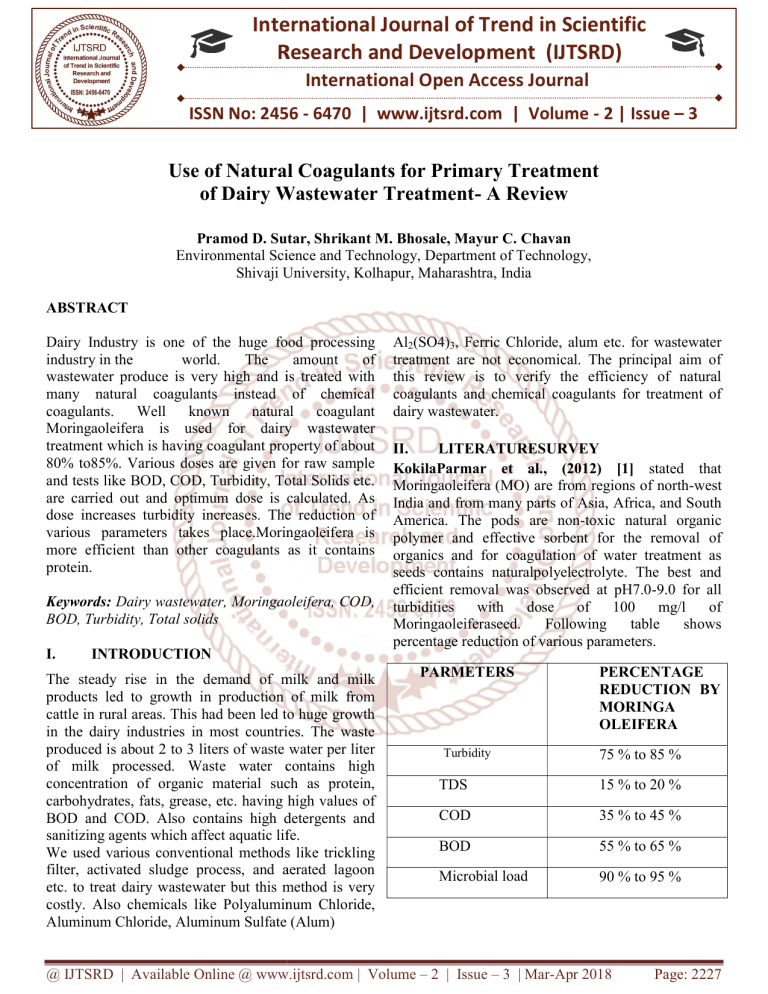
International Journal of Trend in Scientific
Research and Development (IJTSRD)
International Open Access Journal
ISSN No: 2456 - 6470 | www.ijtsrd.com | Volume - 2 | Issue – 3
Use of Natural Coagulants for Primary Treatment
of Dairy Wastewater Treatment
Treatment- A Review
Pramod D. Sutar, Shrikant M. Bhosale, Mayur C. Chavan
Environmental Science and Technology, Department of Technology,
Shivaji University, Kolhapur, Maharashtra, India
ABSTRACT
Dairy Industry is one of the huge food processing
industry in the
world.
The
amount
of
wastewater produce is very high and is treated with
many natural coagulants instead of chemical
coagulants.
Well
known
natural
coagulant
Moringaoleifera is used for dairy
ry wastewater
treatment which is having coagulant property of about
80% to85%. Various doses are given for raw sample
and tests like BOD, COD, Turbidity, Total Solids etc.
are carried out and optimum dose is calculated. As
dose increases turbidity increases.
s. The reduction of
various parameters takes place.Moringaoleifera is
more efficient than other coagulants as it contains
protein.
Keywords: Dairy wastewater, Moringaoleifera, CO
COD,
BOD, Turbidity, Total solids
I.
INTRODUCTION
The steady rise in the demand of milk and milk
products led to growth in production of milk from
cattle in rural areas. This had been led to huge growth
in the dairy industries in most countries. The waste
produced is about 2 to 3 liters of waste water per liter
of milk processed. Wastee water contains high
concentration of organic material such as protein,
carbohydrates, fats, grease, etc. having high values of
BOD and COD. Also contains high detergents and
sanitizing agents which affect aquatic life.
We used various conventional methodss like trickling
filter, activated sludge process, and aerated lagoon
etc. to treat dairy wastewater but this method is very
costly. Also chemicals like Polyaluminum Chloride,
Aluminum Chloride, Aluminum Sulfate (Alum)
Al2(SO4)3, Ferric Chloride, alum etc.
e for wastewater
treatment are not economical. The principal aim of
this review is to verify the efficiency of natural
coagulants and chemical coagulants for treatment of
dairy wastewater.
II.
LITERATURESURVEY
KokilaParmar et al., (2012) [1] stated that
Moringaoleifera (MO) are from regions of north-west
north
India and from many parts of Asia, Africa, and South
America. The pods are non-toxic
non
natural organic
polymer and effective sorbent for the removal of
organics and for coagulation of water treatment as
seeds
ds contains naturalpolyelectrolyte. The best and
efficient removal was observed at pH7.0-9.0
pH7.0
for all
turbidities
with
dose
of
100
mg/l
of
Moringaoleiferaseed.
Following
table
shows
percentage reduction of various parameters.
PARMETERS
Turbidity
PERCENTAGE
REDUCTION BY
MORINGA
OLEIFERA
75 % to 85 %
TDS
15 % to 20 %
COD
35 % to 45 %
BOD
55 % to 65 %
Microbial load
90 % to 95 %
@ IJTSRD | Available Online @ www.ijtsrd.com | Volume – 2 | Issue – 3 | Mar-Apr
Apr 2018
Page: 2227
International Journal of Trend in Scientific Research and Development (IJTSRD) ISSN: 2456-6470
It is concluded that the MO seeds have the potential to
be used in the dairy industry waste water treatment in
an efficient way and with low cost.
Chitteti Ramamurthy et al., (2012) [2]describes that
the ability of seed extracts of Trigonellafoenumgraecum
(T.
foenum-graecum)
and
Cuminumcyminum (C. cyminum) to act as natural
coagulants. These extracts tested using natural turbid
water and prepared using distilled water and NaCl
(0.5 M and 1.0 M) solution. Only 1.0 M NaCl extract
of T. foenum-graecum had coagulation capability and
did not depend on pH values. Following table shows
coagulation properties of various natural coagulants
and chemical coagulant aluminum sulphate for the
pre-sent study.
COAGULANT
T. foenum-graecum
COAGULATION
PROPERTIES IN
PERCENTAGE
75-85
Strychnospotatorum
85-95
Moringaoleifera
60-70
Aluminum Sulphate
90-97
When compared with pond water, T. foenum-graecum
extract treated water shows decrease in alkalinity,
turbidity, KMnO4 demand and total coli-form. This
study concludes that seed extract of T. foenumgraecum can be used as natural water coagulant.
Pallavi N. and Dr. Mahesh S. (2013) [3]presented
thatuse of natural coagulant named MoringaOleifera,
to treat raw dairy wastewater. The Optimum MO
dosage for various particle sizes.
COAGULANTS
PARTICLE SIZE OF OPTIMUM
MO (μm)
(mg/L)
425
300
212
500
150
500
Particle size212μm MoringaOleiferaused in this paper
and following table shows percentage reduction in
various parameters:
PARAMETERS
COD
PERCENTAGE
REDUCTION
64.28
Total solids
53.95
Oil & grease
85.17
Prof. Chidanand Patil1 and Ms. ManikaHugar
(2015) [4]states that the dairy industry wastewater is
characterized by high COD, BOD, nutrients and is to
be treated natural coagulants and then tests are to be
carried to check the water characteristics like BOD,
COD, pH and turbidity, etc. The initial pH, Turbidity,
COD are 7.41. 289.5 NTU, 10000 mg/l respectively.
Natural coagulants to be used are Moringa Oleifera
seeds, Trigonellafoenum-graecum, Dolichos lablab
and Cicerarietinum and efficiency of reduction of
turbidity and COD is given in below table:
REDUCTION OF
TURBIDITY (%)
60-65
REDUCTION OF
COD (%)
60-65
Trigonellafoenum-graecum
55-60
60-65
Dolichos lablab
70-75
72-78
Cicerarietinum
75-80
80-85
MoringaOleifera
The efficiency of Cicerarietinum is more compared to
other three as it depends on the protein content which
is present in the natural coagulant. The increase of
dosage causes the increase of turbidity.
DOSE
Mangesh K. Urade etal., (2017) [5]presented that the
characteristics of wastewater is treated by natural
coagulant like Maringa Oleifera seeds,Trigonella,
Foenum-gracecum, Dolichos and Cicerarietinum. The
efficiency of reduction turbidity as 60-80% and to
dosages increases to increases the turbidity. The
@ IJTSRD | Available Online @ www.ijtsrd.com | Volume – 2 | Issue – 3 | Mar-Apr 2018
Page: 2228
International Journal of Trend in Scientific Research and Development (IJTSRD) ISSN: 2456-6470
MoringaOleifera is one of the most efficient herbal
coagulants to remove the turbidity. The initial BOD
and COD dose of dairy wastewater is 58-60%
respectively and residual BOD remained below 500
mg/l. The maximum discharged of treated effluent
limit is allowed to land through irrigation.
ChaitaliBangar et al., (2017) [6] describes that dairy
industry wastewater discharges which characterized
by High COD, BOD, TSS, TDS, Turbidity, pH etc.
Water resources get polluted if untreated waste water
discharged into natural resources. The efficiency of
Different Chemical Coagulant (alum) and Natural
coagulant moringaoleifera (MO) was compared under
same analytical conditions. The comparison of
various parameters by natural coagulant and chemical
coagulant shown in following table:
PARMETERS
pH
REDUCTION
BY MO
7.4 to 7.1
REDUCTION
BY ALUM
-
Turbidity
65 % to 70 %
75 % to 80 %
TDS
65 % to 70 %
70 % to 75 %
COD
50 % to 55 %
55 % to 60 %
BOD
85 % to 90 %
90 % to 95 %
Hence by analyzing above results alum is more
effective than moringaoleifera.
Neena Sunny et al., (2015) [7]stated thatnatural
coagulant Moringaoleifera (MO) used for treatment of
waste water at optimum air rate and optimum time
period. The reduction in turbidity was between 70 to
80% at the optimum dose of 6mg/L.
Neethu.P et al., (2017)[8] presented that the huge
amount of waste water produced from dairy industry
is
treated
using
natural
coagulant
MoringaOleiferawhich are easily available. The
various tests like BOD, COD, turbidity, etc. are
carried out before and after coagulation process. The
optimum dose is 0.3 g/l. The reduction of
variousparameters shown in table below:
PARMETERS
PERCENTAGE
REDUCTION
Turbidity
75-80
BOD
75-80
COD
85-90
Total solids
8-10
Total Suspended
95-100
Solids
D.S. Bhutada et al., (2008) [9] described that herbal
coagulant MoringaOleifera is very useful in removal
of turbidity and other parameters in water and waste
water. Use of this coagulant in primary treatment of
industrial wastewater is explored. . Coagulation,
flocculation and sedimentation were conducted on
laboratoryusing Moringaoleifera. The results were
good enough and quit encouraging at the optimum
dose of 60 mg/L. The percentage reduction of BOD
was about 50-55% and that of COD was about 6065%. By using fuller earth as coagulant (15 mg/L)
these reductions were further increased by 5% and 6%
respectively. BOD was reduced to 55-60% and COD
was reduced up to 65-70% by preliminary and
primary treatment together. And the residual BOD5
was observed below 500 mg/L which is maximum
limit for treated effluent to be discharge of on land.
III.
SUMMERY OF LITERATURE
At pH 7-9Moringaoleifera is very efficient in removal
of turbidity and other parameters at dose of 100 mg/l.
Percentage reduction of microbial load (90-95%) is
more than that of percentage removal of turbidity,
TDS, COD and BOD [1].
M NaCl extract of T. foenum-graecum had coagulant
capacity than that of 0.5 M NaCl which did not
depend on pH values. Maximum coagulation property
is of Aluminum Sulphatei.e 90-97% as compare to
natural
coagulants
T.
foenum-graecum,
Strychnospotatorum, Moringaoleifera and Aluminum
Sulphate. After Aluminum Sulphate, T. foenumgraecum has good coagulation property which used
for treatment of water and showed decrease in
alkalinity, turbidity, KMnO4 demand and total coliform [2].
The optimum dose of MoringaOleifera is given for
various particle sizes and size of 212μm with dose
500 mg/L used. Reduction of oil & grease is 85%
which is maximum than that of reduction of COD and
Total solids [3].
By using cicerarietinum removal of COD and
turbidity is maximum i.e 75-85% followed by
Dolichos lablab, Trigonellafoenum-graecum and
MoringaOleifera [4].
The efficiency of reduction of turbidity by Maringa
Oleifera
seeds,Trigonella,
Foenum-gracecum,
Dolichos and Cicerarietinum is about 60% and results
of reduction of BOD and COD is below 500 mg/l [5].
The comparison of MoringaOleifera and chemical
coagulant alum is done and good results are of alum
than natural coagulant [6].
@ IJTSRD | Available Online @ www.ijtsrd.com | Volume – 2 | Issue – 3 | Mar-Apr 2018
Page: 2229
International Journal of Trend in Scientific Research and Development (IJTSRD) ISSN: 2456-6470
The turbidity removal by MoringaOleifera is about
70-80% and no other parameters are considered [7].
At dose of 0.3 g/l of MoringaOleifera there is
maximum reduction of pH, COD, BOD, Total Solids
and Total Suspended solids [8].
At dose of 60 mg/l of MoringaOleifera and using
fuller earth 15 mg/l reduction of BOD is 55 to 60%
and reduction of COD is 65 to 70%.
From
above
results
natural
coagulant
MoringaOleiferacan be used for coagulation process.
The best among all is, dose of 0.3 g/l is optimum for
maximum removal COD, BOD, turbidity, TDS and
TSS [8]. Also if along with alum natural coagulants
are use the results would be encouraging. For dairy
industry coagulation and flocculation unit would be
beneficial as a primary treatment with this natural
coagulant as the load on Effluent Treatment Plant can
be reduced reduce more parameters as discussed
above.
IV.
CONCLUSION
As the waste water from dairy industry causes
environmental and health problems proper treatment
is necessary. Various conventional methods like
trickling filter, activated sludge process, and aerated
lagoon etc. used to treat dairy wastewater but this
method is very costly. Also chemicals like
Polyaluminum Chloride, Aluminum Chloride,
Aluminum Sulfate (Alum) Al2(SO4)3, Ferric
Chloride, alum etc. for wastewater treatment are not
economical.
In technical terms, these natural coagulants are highly
efficient for reduction of physical chemical
parameters of the wastewater such as colour,
turbidity, COD, BOD, TS and others. Planted-based
coagulants also have several reasons to become
effective coagulant; high cationic charge density, long
polymer chains, bridging of aggregates and
precipitation, safe, non-toxic, increasing floc size,
eco-friendly, high biodegradability, reducing sludge
volume, reduction in cost as it is raw material from
renewable resources. The results carried out by
researches for natural coagulant MoringaOleifera are
very encouraging by dose 0.3g/l can be best for
reduction of various parameters which can be used for
dairy waste water treatment.
REFERENCES
1. KokilaParmar, YogeshDabhi, Rinku Patel and
SarjuPrajapati, “Effectiveness of Moringaoleifera
as natural coagulant aid for waste water treatment
of dairy industry”, ASIAN JOURNAL OF
ENVIRONMENTAL SCIENCE VOLUME 7
ISSUE 2 DECEMBER, 2012 pp. 167-171
2. Chitteti Ramamurthy, Malige Uma Maheswari1,
NatarajanSelvaganabathy,
Muthuvel
Suresh
Kumar,
VenugopalSujatha
and
ChinnasamyThirunavukkarasu, “Evaluation of
eco-friendly coagulant from Trigonellafoenumgraecumseed”, Advances in Biological Chemistry,
2012, pp. 58-63
3. Pallavi N. and Dr. Mahesh S., “Feasibility Study
of MoringaOleifera as a Natural Coagulant for the
Treatment of Dairy Wastewater”, International
Journal of Engineering Research (ISSN : 23196890) Volume No.2, Issue No.3, pp. 200-202
4. Prof. ChidanandPatil and Ms. ManikaHugar,
“Treatment of dairy wastewater by natural
coagulants”, International Research Journal of
Engineering and Technology (IRJET) Volume: 02
Issue: 04 July-2015, pp. 1120-2225
5. Mangesh K. Urade, Mangesh K. Urade and
Manisha G. Wasnik, “Comparative Study of Dairy
Wastewater Treatment by Natural Coagulant”,
International Research Journal of Engineering and
Technology (IRJET) Volume 3, June 2017, pp.
43-48
6. ChaitaliBangarPoojaMhaske, VanitaParasur and
SonaliPawar, “Comparative Study of Removal of
Dairy Waste Characteristics by Using Various
Natural and chemical Coagulants”, International
Journal of Research in Advent Technology
(IJRAT) Special Issue E-ISSN: 2321-9637
National Conference “MOMENTUM-17”, 14th&
15th February 2017, pp. 1-3
7. Neena
Sunny,
FathimaShukkoor,
FathimathNuzrin N R and MuhsinaMoideen,
“Treatment of Dairy waste”, International Journal
of Civil and Structural Engineering Research Vol.
2, Issue 2, Month: October 2014 - March 2015,
pp. 140-144
8. Neethu. P, Navami. D And Anitha. K, “Treatment
of Dairy Waste Water By MoringaOleifera as
Natural Coagulant”, International Research
Journal of Engineering and Technology (IRJET)
Vol-3 Issue-4 2017, pp. 1448-1453
9. D.S. Bhutada, M.T. Datar and S.N. Kaul, “Use of
Herbal Coagulant for Primary Treatment of Dairy
Wastewater”, Jr. of Industrial Pollution Control 22
(1)(2006), pp. 139-148
@ IJTSRD | Available Online @ www.ijtsrd.com | Volume – 2 | Issue – 3 | Mar-Apr 2018
Page: 2230

